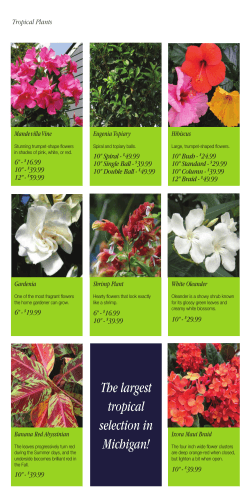
Heritage Week Quiz - Nelson City Council
e g a t i r e H z elson.govt.n .n w w w n o Full details Z I U Q K E E W 5 1 April 20 11-19 During Heritage Week we are celebrating all sorts of ways to stay healthy. The Maitai River is a great place to relax around, and has provided fresh water for the city for a long time. Have fun along the Maitai River pathway discovering native plants with interesting uses. Fill in your entry form and put in the Quiz box at Elma Turner Library, Council Customer Service centre or Nelson Provincial Museum by 4pm Friday 17 April. You may be a lucky winner! Prizes include swim and movie passes. Write the name of a plant described on the flipside of this page, against the number of each location shown on the map. Each plant can only be used ONCE, You will need to visit all the locations as some plants will be found in several locations, some in only one. The pictures may not exactly match as some may show flowers so read descriptions too. Remember some plants are poisonous so do not eat them, but leave to grow and keep our riverbanks strong and beautiful. 6 m fro t e ass erp n Stre d n U rste AY HW Ake HIG E T STA ter wa dge Salt ek Bri Cre Name Contact/email TRAFALGAR PARK 6 Phone Age Map location OT FO Car parks D OA RU R Wooden view point G RID 2 B 3 4 A PARU P KEY 1 E 5 Name of plant, use each ONCE only 5 4 7 3 Information panel 6 8 Ne Br lson as C s H ity all 7 8 Playground M 2 RI VE Sculpture Walk/Cycle Path 1 Toilets Seats Water fountain Supermarket Library R TRAFALGAR STREET BRIDGE I TA AI Waka Landing Area MAITAI WALKWAY Pick up a Heritage Week programme for more activities or go online to www.nelson.govt.nz for more information. e g a t i Her 11-19 Apri K l 2015 WEE HARAKEKE ( FLAX) Ma-ori discovered many uses for flax. The nectar from its flowers made a sweet drink. The roots could be crushed to make a poultice for skin infections and the juice used as a disinfectant or a laxative. The gum from the base of the leaves eased pain and healed wounds, especially burns. The leaves could be used to make bandages and to secure broken bones. Fibres from the leaves could be twisted, plaited and woven, and used to create a wide range of items, such as fishing nets and traps, footwear and cords. KARAKA In autumn the Karaka berries ripen from green through to yellow and red. Maori had a long process to make the ripe fruit edible, as the fresh kernels contain the lethal alkaloid poison karakin. This causes violent convulsions and severe muscle spasms which can leave the limbs permanently fixed in contorted positions so they were very careful. The Karaka tree is thought to have been brought to New Zealand on the Kurahaupo- (canoe) and is widespread in mainly coastal situations. KOWHAI The name ko-whai comes from the Ma-ori word for yellow. All parts of the Ko-whai, are poisonous to humans. Traditionally the Ma-ori used the flexible branches as a construction material in their houses and to snare birds. The Ko-whai flowers can be used to make a yellow dye. Tui are very attracted to Ko-whai and will fly long distances to get a sip of its nectar. Ma-ori would also use the Ko-whai tree as medicine. The bark was heated in a calabash with hot stones, and made into a poultice to treat wounds or rubbed on a sore back or made into an infusion to treat bruising or muscular pains. PIRIPIRI - NATIVE BIDIBID This plant grows along the ground and has a spiky flower that can catch on your clothes. The leaves were once used as a tea to help with bladder and kidney troubles. An infusion was also used on open wounds. CABBAGE TREE The trunk of the Cabbage tree is so fire-resistant that early European settlers used it to make chimneys for their huts. Ma-ori used Cabbage trees as a food, fibre and medicine. The root, stem and top are all edible, a good source of starch and sugar. The flower has a distinct sweet perfume. HEBE KOROMIKO (WHITE FLOWER) There are many varieties of Hebe but the local variety has white flowers. Koromiko leaves are used in rituals by the tohunga to ensure a good crop of kumara and the tips of shoots can be chewed to alleviate hunger. Diarrhoea and dysentery are treated by eating the fresh young leaves and shoots, or by drinking a liquid in which they were boiled. The remedy was used by troops in WW1. TITOKI The red berries of the Titoki attract native birds such as the New Zealand Wood Pigeon and its leaves and oil are a natural insect repellent. It was formerly known as New Zealand Oak but is now best known by its Ma-ori name. POHUTUKAWA The Pohutukawa is often called the New Zealand Christmas tree. It has vibrant red flowers and an ability to survive even perched on rocky, precarious cliffs. It can sprout adventitious roots that can grow in air as they search for crevices, pockets of soil and moisture. It is regarded as a chiefly tree (ra-kau rangatira) by Ma-ori. They are very slow growing and can live over 1000 years. The timber is ideal for boat construction as it is immune to seaworms when exposed to salt water. www.nelson.govt.nz (search phrase = heritage week)
© Copyright 2025




















